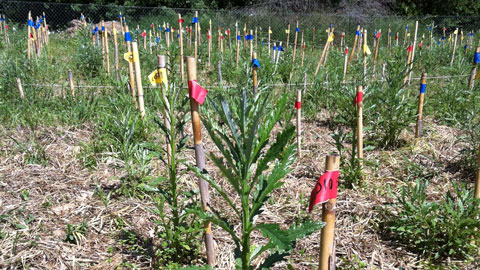Climate change accelerates the evolution of invasive plant

05/05/2015
Biological invasions represent one of the greatest problems affecting biodiversity at global level. The study of invasive species, however, can also provide information on the response of organisms undergoing changes in their environments. Current hypotheses predict that invasive plants could evolve rapidly and adapt themselves to new habitats and under different environmental conditions.
The quick evolution of exotic species has been a determining factor in their proliferation. Invasive plants present genetic traits that are different from native plants. The differential traits which represent an advantage, such as the ability to grow quicker or reproduce better, have been improved through natural selection. But the characterisation of these traits is complicated, given that they depend on the climatic conditions of each ecosystem.
The fact that exotic plants evolve quicker when they are outside of their original environment is often attributed to the lack of herbivores and a greater phenotypic plasticity, i.e. the ability to express different genetic-related characteristics depending on the existing environmental conditions. But these are only hypotheses and they have not yet been tested out jointly.
UAB and CREAF researchers, led by Eva Castells, lecturer from the UAB Department of Pharmacology, Therapeutics and Toxicology, have studied how invasive plants respond to environmental changes by using the model species Senecio pterophorus. The plant, originally from Africa, expanded from eastern to western South Africa some 100 years ago, arrived to Australia 70 years ago, and reached Europe only 30 years ago. Three areas with very different climates and populations of herbivores which may have contributed to changes in the morphology of this species. The conditions in their original habitat are much more humid with hotter summers, and the species is more exposed to attacks from herbivores than in the areas in which they were later introduced.
Scientists have studied 47 invasive plant populations, with seeds from the native area and from all three of the geographic areas in which the invasive plant is present. The plant was cultivated in experimental fields with similar environmental conditions and scientists pinpointed the genetic difference found in their morphology (leaf size, growth) and in their reproductive characteristics.
They observed that the invasive plants are smaller, have less reproductive capacity and also have smaller leaves than their native counterparts. This data contradicts the hypothesis which affirms that herbivore attacks are related to the changes in characteristics of these plants. In contrast, the results demonstrate that climate conditions accelerate evolutionary changes in invasive plants.
According to coordinator of the study Eva Castells, “understanding the mechanisms behind a rapid differentiation in response to new climatic conditions improves our abilities to explain the dynamics of biological invasions and predict the response of native populations when exposed to a climate change scenario”.
The research, published in the journal Functional Ecology, included the participation of researchers from the Centre for Ecological Research and Forestry Applications (CREAF) and from the UAB Department of Animal Biology, Plant Biology and Ecology: Ferran Colomer and Jordi Martínez-Vilalta; Anna Escolà, from the UAB Department of Pharmacology, Therapeutics and Toxicology; Laura Armengot, from the UB Faculty of Biology; and Paolo Zuccarini, from the Institute of Agri-food Research and Technology (IRTA).